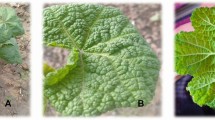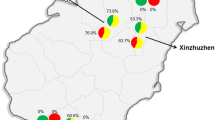Abstract
Cotton leaf curl disease (CLCuD) is a major constraint in the production of cotton crop across the Africa and Asia which is caused by a complex of begomoviruses (family Geminiviridae). Cotton leaf curl Khokhran virus and associated Cotton leaf curl Multan betasatellite (CLCuKoV/CLCuMB) complex are important agents of CLCuD which transmitted by whiteflies of the Bemisia tabaci species complex. Information regarding the transmission efficiency of CLCuKoV/CLCuMB by whitefly cryptic species is seriously lacking in Pakistan, therefore present study is conducted for comparison of transmission efficiency of CLCuKoV/CLCuMB by two characterized whitefly cryptic species (Asia II-1 and Asia II-5). Whitefly cryptic species were reared separately on Nicotiana benthamiana plants infected with CLCuKoV/CLCuMB for 24 or 48 h and these infected whitefly cryptic species were transferred to un-infected cotton and alternative host plants for 24 or 48 h. The first experiment results showed that Asia II-1 was able to transmit CLCuKoV/CLCuMB with high efficiency in cotton and bitter gourd plants as compared to the Asia II-5 while other host plants did not develop symptoms. Further in the second experiment results revealed that Asia II-1 was able to transmit CLCuKoV/CLCuMB with high efficiency from symptomatic bitter gourd to cotton plants as compared to Asia II-5 which did not show symptoms of transmission. Infection symptoms were confirmed by visual inspection after 30 days and PCR analysis. We found the percentage of virus infection symptoms in alternate host plants differed between two whitefly cryptic species due to varying transmission efficiencies. This research finding advances our understanding to explore the whitefly cryptic species involved in the transmission of CLCuD and will aid in the development of management strategies for control of whitefly cryptic species and CLCuD transmission in Pakistan.









Similar content being viewed by others
Data Availability
On convincing demand, the corresponding author will provide all data and materials described in the manuscript available.
References
Acharya R, Shrestha YK, Khatun MF, Lee KY (2021) Identification of Begomoviruses from Three Cryptic Species of Bemisia tabaci (Gennadius) (Hemiptera: Aleyrodidae) in Nepal. Agron 11:2032
Ahmed MZ, De Barro PJ, Greeff JM, Ren SX, Naveed M, Qiu BL (2011) Genetic identity of the Bemisia tabaci, species complex and association with high cotton leaf curl disease (CLCuD) incidence in Pakistan. Pest Manag Sci 67:307–317
Akram A, Rasool G, Rehman A, Mansoor S, Briddon RW, Saeed M (2017) Identification of cotton leaf curl Kokhran virus and multiple satellite molecules infecting Jasminum sambac in Pakistan. J Plant Pathol 99:804. http://www.sipav.org/main/jpp/index.php/jpp/article/view/3967/2611
Amrao L, Akhter S, Tahir MN, Amin I, Briddon RW, Mansoor S (2010) Cotton leaf curl disease in Sindh province of Pakistan is associated with recombinant begomovirus components. Virus Res 153:161–165
Anonymous (2019) Economic survey of Pakistan, 2018-19. Economic Adviser’s Wing. Finance Division, Government of Pakistan, Islamabad
Ashfaq M, Hebert PDN, Mirza MS, Khan AM, Mansoor S, Shah GS, Zafar Y (2014) DNA barcoding of Bemisia tabaci complex (Hemiptera: Aleyrodidae) reveals southerly expansion of the dominant whitefly species on cotton in Pakistan. PLoS ONE 9:e104485
Ashraf J, Zuo D, Wang Q, Malik W, Zhang Y, Abid MA, Cheng H, Yang Q, Song G (2018) Recent insights into cotton functional genomics: progress and future perspectives. Plant Biotechnol J 16:699–713
Biswas KK, Bhattacharyya UK, Palchoudhury S, Balram N, Kumar A, Arora R, Sain SK, Kumar P, Khetarpal RK, Sanyal A, Mandal PK (2020) Dominance of recombinant cotton leaf curl Multan-Rajasthan virus associated with cotton leaf curl disease outbreak in northwest India. PLoS ONE 15:e0231886
Boykin LM, De Barro P (2014) A practical guide to identifying members of the Bemisia tabaci species complex: and other morphologically identical species. Front Ecol Evol 2:45
Briddon RW, Markham PG (2000) Cotton leaf curl virus disease. Virus Res 71:151–159
Chen LF, Rojas M, Kon T, Gamby K, Xoconostle B, Gilbertson RL (2009) A severe symptom phenotype in tomato in Mali is caused by a reassortant between a novel recombinant begomovirus (tomato yellow leaf curl Mali virus) and a betasatellite. Mol Plant Pathol 10:415–430
Chen T, Saeed Q, He Z, Lu L (2019) Transmission efficiency of cotton leaf curl Multan virus by three cryptic species of Bemisia tabaci complex in cotton cultivars. Peer J 7:e7788
Chen T, Tang Y, Zhao R, He Z (2016) Identification of the cryptic species of Bemisia tabaci transmitting cotton leaf curl Multan virus. Acta Phytophylacica Sin 43:91–98
Czosnek H, Ghanim M, Ghanim M (2002) The circulative pathway of begomoviruses in the whitefly vector Bemisia tabaci - insights from studies with Tomato yellow leaf curl virus. Ann Appl Biol 140:215–231
Farooq J, Farooq A, Riaz M, Shahid MR, Saeed F, Iqbal MS, Hussain T, Batool A, Mahmood A (2014) Cotton leaf curl virus disease a principle cause of decline in cotton productivity in Pakistan (a mini review). Can J Plant Prot 2:9–16
Fiallo-Olivé E, Pan LL, Liu SS, Navas-Castillo J (2020) Transmission of begomoviruses and other whitefly-borne viruses: dependence on the vector species. Phytopathology 110:10–17
Frohlich DR, Torres-Jerez I, Bedford ID, Markham PG, Brown JK (1999) A phylogeographical analysis of the Bemisia tabaci species complex based on mitochondrial DNA markers. Mol Ecol 8:1683–1691
Gangwar RK, Gangwar C (2018) Lifecycle, distribution, nature of damage and economic importance of whitefly, Bemisia tabaci (Gennadius). Acta Sci Agric 2:36–39
Gupta VK, Sharma R, Singh S, Jindal J, Dilawari VK (2010) Efficiency of Bemisia tabaci (Gennadius) populations from different plant-hosts for acquisition and transmission of cotton leaf curl virus. Indian J Biotechnol 9:271–275
Harrison BD, Liu YL, Khalid S, Hameed S, Otim-Nape GW, Robinson DJ (1997) Detection and relationships of cotton leaf curl virus and allied whitefly-transmitted geminiviruses occurring in Pakistan. Ann Appl Biol 130:61–75
Hussain T, Ali M (1975) A review of cotton diseases of Pakistan. The Pak Cotton 19:71–86
Islam W, Lin W, Qasim M, Islam SU, Ali H, Adnan M, Arif M, Du Z, Wu Z (2018) A nation-wide genetic survey revealed a complex population structure of Bemisia tabaci in Pakistan. Acta Trop 183:119–125
Khan Z, Khan SH, Ahmad A, Aslam S, Mubarik MS, Khan S (2019) CRISPR/dCas9-mediated inhibition of replication of begomoviruses. Int J Agric Biol 21:711–718
Mann RS (2011) Bemisia tabaci interaction with cotton leaf curl virus. In: the Whitefly, Bemisia tabaci (Homoptera: Aleyrodidae) interaction with Geminivirus-infected host plants. Springer: Dordrecht, pp 69–88
Mansoor S, Amin I, Iram S, Hussain M, Zafar Y, Malik KA, Briddon RW (2003) Breakdown of resistance in cotton to cotton leaf curl disease in Pakistan. Plant Pathol 52:784–784
Mansoor S, Khan SH, Saeed M, Bashir A, Zafar Y, Malik KA, Markham PG (1997) Evidence for the association of a bipartite geminivirus with tomato leaf curl disease in Pakistan. Plant Dis 81:958–958
Masood M, Amin I, Hassan I, Mansoor S, Brown JK, Briddon RW (2017) Diversity and distribution of cryptic species of the Bemisia tabaci (Hemiptera: Aleyrodidae) complex in Pakistan. J Econ Entomol 110:2295–2300
Njoroge MK, Mutisya DL, Miano DW, Kilalo DC (2017) Whitefly species efficiency in transmitting cassava mosaic and brown streak virus diseases. Cogent Biol 3:1311499
Ohnishi J, Kitamura T, Terami F, Honda K (2009) A selective barrier in the midgut epithelial cell membrane of the non-vector whitefly Trialeurodes Vaporario- rum to Tomato yellow leaf curl virus uptake. J Gen Plant Pathol 75:131139. https://doi.org/10.1007/s10327-009-0147-3
Ouattara A, Tiendrebeogo F, Lefeuvre P, Hoareau M, Claverie S, Allibert A, Chiroleu F, Traoré EV, Barro N, Traoré O, Lett JM (2020) Diversity, distribution and prevalence of vegetable-infecting geminiviruses in Burkina Faso. Plant Pathol 69:379–392
Pan LL, Chen QF, Zhao JJ, Guo T, Wang XW, Hariton-Shalev A, Czosnek H, Liu SS (2017) Clathrin-mediated endocytosis is involved in Tomato yellow leaf curl virus transport across the midgut barrier of its whitefly vector. Virology 502:152–159
Pan LL, Cui XY, Chen QF, Wang XW, Liu SS (2018) Cotton leaf curl disease: which whitefly is the vector? Phytopathol 108:1172–1183
Panhwar GR, Panhwar GA, Soomro AW, Magsi MR, Leghari AB (2001) Survey of cotton leaf curl virus (CLCV) in Sindh. J Biol Sci 1:134–135
Paredes-Montero JR, Hameed U, Zia-Ur-Rehman M, Rasool G, Haider MS, Herrmann HW, Brown JK (2019) Demographic expansion of the predominant Bemisia tabaci (Gennadius) (Hemiptera: Aleyrodidae) mitotypes associated with the cotton leaf curl virus epidemic in Pakistan. Ann Entomol Soc Am 112:265–280
Peng J, Xie G, Zhang S, Zheng L, Gao Y, Zhang Z, Luo L, Su P, Wang D, Liu Y, Dai L (2020) Higher Ramie mosaic virus transmission efficiency by females than by males of Bemisia tabaci MED. Sci Rep 10:1–6
Polston JE, De Barro P, Boykin LM (2014) Transmission specificities of plant viruses with the newly identified species of the Bemisia tabaci species complex. Pest Manag Sci 70:1547–1552
Rajagopalan PA, Naik A, Katturi P, Kurulekar M, Kankanallu RS, Anandalakshmi R (2012) Dominance of resistance-breaking cotton leaf curl Burewala virus (CLCuBuV) in northwestern India. Arch Virol 157:855–868
Rosen R, Kanakala S, Kliot A, Cathrin PB, Farich BA, Santanamagal N, Elimelech M, Kontsedalov S, Lebedev G, Cilia M, Ghanim M (2015) Persistent, circulative transmission of begomoviruses by whitefly vectors. Curr Opin Virol 15:1–8
Ruan YM, Luan JB, Zang LS, Liu SS (2007) Observing and recording copulation events of whiteflies on plants using a video camera. Entomol Exp Appl 124:229–233
Sattar MN, Iqbal Z, Tahir MN, Ullah S (2017) The prediction of a new CLCuD epidemic in the Old World. Front Microbiol 8:631
Sattar MN, Kvarnheden A, Saeed M, Briddon RW (2013) Cotton leaf curl disease - an emerging threat to cotton production worldwide. J Gen Virol 94:695–710
Shah SH, Malik AH, Qazi J (2013) Identification of new genetic variant of Bemisia tabaci from Pakistan. Int J Entomol Res 01:16–24
Shah SIA, Malik TH, Khan IR, Hussain Z (2017) Screening of USDA cotton accessions against sucking insect pests complex and cotton leaf curl virus (CLCuV) disease with major emphasis on abiotic factors. Pak J Zool 49:1159–1173
Simon C, Frati F, Beckenbach A, Crespi B, Liu H, Flook P (1994) Evolution, weighting, and phylogenetic utility of mitochondrial gene sequences and a compilation of conserved polymerase chain reaction primers. Ann Entomol Soc Am 87:651–701
Wang XW, Blanc S (2020) Insect transmission of plant single-stranded DNA viruses. Annu Rev Entomol 66
Wei J, Zhao JJ, Zhang T, Li FF, Ghanim M, Zhou XP, Ye GY, Liu SS, Wang XW (2014) Specific cells in the primary salivary glands of the whitefly Bemisia tabaci control retention and transmission of begomoviruses. J Virol 88:13460–13468
Xia WQ, Liang Y, Chi Y, Pan LL, Zhao J, Liu SS, Wang XW (2018) Intracellular trafficking of begomoviruses in the midgut cells of their insect vector. PLoS Pathog 14:e1006866
Zaidi SSEA, Shafiq M, Amin I, Scheffler BE, Scheffler JA, Briddon RW, Mansoor S (2016) Frequent occurrence of Tomato leaf curl New Delhi virus in cotton leaf curl disease affected cotton in Pakistan. PLoS ONE 11:e0155520
Acknowledgements
We sincerely thank Dr. Zulqurnain Khan, Assistant Professor, Institute of Plant Breeding and Biotechnology for providing infectious clones and Punjab Agriculture Research Board for financial support under PARB project No. 889 to complete this research work.
Author information
Authors and Affiliations
Contributions
MA and SS designed and carried out the experiments, analyzed the data and wrote the paper. HR, MI and Habib-ur-Rehman provided the technical support. All authors read and approved the final manuscript.
Corresponding author
Ethics declarations
Conflict of interest
The authors have no conflict of interest.
Disclaimer
Any opinion, finding, and conclusion or recommendation expressed in this article is that of the author(s), and the funding agencies do not accept any liability in this regard.
Additional information
Publisher’s Note
Springer Nature remains neutral with regard to jurisdictional claims in published maps and institutional affiliations.
Rights and permissions
Springer Nature or its licensor (e.g. a society or other partner) holds exclusive rights to this article under a publishing agreement with the author(s) or other rightsholder(s); author self-archiving of the accepted manuscript version of this article is solely governed by the terms of such publishing agreement and applicable law.
About this article
Cite this article
Afzal, M., Saeed, S., Riaz, H. et al. Transmission efficiency of Cotton leaf curl Khokhran virus /Cotton leaf curl Multan betasatellite complex by two whitefly cryptic species in Pakistan. Int J Trop Insect Sci 43, 819–830 (2023). https://doi.org/10.1007/s42690-023-00991-y
Received:
Accepted:
Published:
Issue Date:
DOI: https://doi.org/10.1007/s42690-023-00991-y




